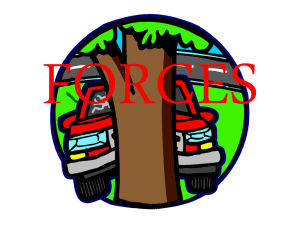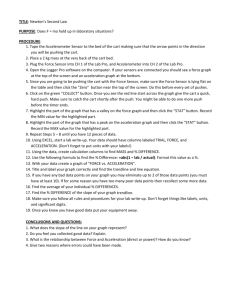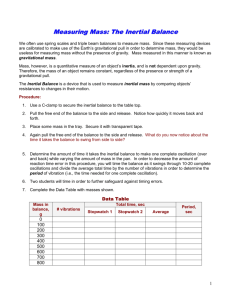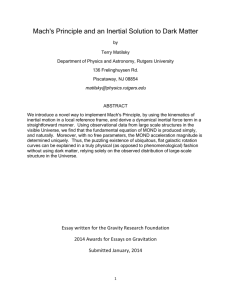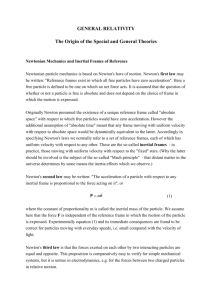INVESTIGATION 1-A Measuring Inertial Mass
advertisement
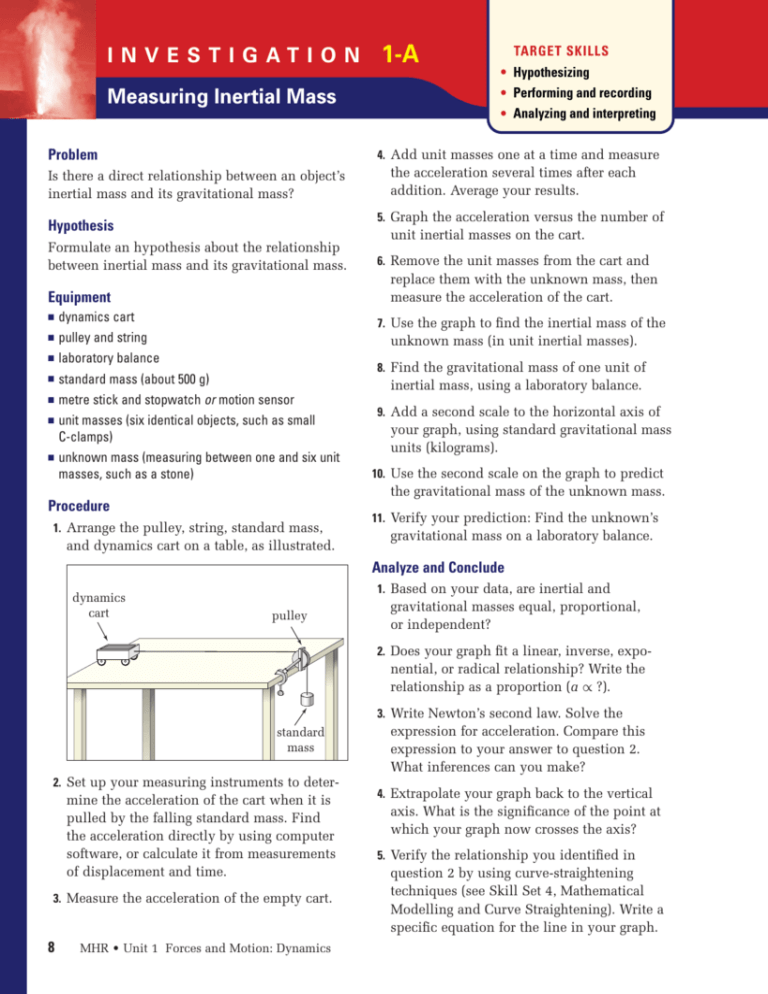
I N V E S T I G AT I O N 1-A Measuring Inertial Mass 4. Add unit masses one at a time and measure Problem Is there a direct relationship between an object’s inertial mass and its gravitational mass? Formulate an hypothesis about the relationship between inertial mass and its gravitational mass. ■ ■ ■ ■ ■ unit inertial masses on the cart. 6. Remove the unit masses from the cart and replace them with the unknown mass, then measure the acceleration of the cart. Equipment ■ the acceleration several times after each addition. Average your results. 5. Graph the acceleration versus the number of Hypothesis ■ TARGET SKILLS Hypothesizing Performing and recording Analyzing and interpreting dynamics cart pulley and string laboratory balance standard mass (about 500 g) metre stick and stopwatch or motion sensor unit masses (six identical objects, such as small C-clamps) unknown mass (measuring between one and six unit masses, such as a stone) 7. Use the graph to find the inertial mass of the unknown mass (in unit inertial masses). 8. Find the gravitational mass of one unit of inertial mass, using a laboratory balance. 9. Add a second scale to the horizontal axis of your graph, using standard gravitational mass units (kilograms). 10. Use the second scale on the graph to predict the gravitational mass of the unknown mass. Procedure 1. Arrange the pulley, string, standard mass, and dynamics cart on a table, as illustrated. 11. Verify your prediction: Find the unknown’s gravitational mass on a laboratory balance. Analyze and Conclude dynamics cart 1. Based on your data, are inertial and pulley gravitational masses equal, proportional, or independent? 2. Does your graph fit a linear, inverse, expo- nential, or radical relationship? Write the relationship as a proportion (a ∝ ?). 3. Write Newton’s second law. Solve the standard mass 2. Set up your measuring instruments to deter- mine the acceleration of the cart when it is pulled by the falling standard mass. Find the acceleration directly by using computer software, or calculate it from measurements of displacement and time. 3. Measure the acceleration of the empty cart. 8 MHR • Unit 1 Forces and Motion: Dynamics expression for acceleration. Compare this expression to your answer to question 2. What inferences can you make? 4. Extrapolate your graph back to the vertical axis. What is the significance of the point at which your graph now crosses the axis? 5. Verify the relationship you identified in question 2 by using curve-straightening techniques (see Skill Set 4, Mathematical Modelling and Curve Straightening). Write a specific equation for the line in your graph. Over many years of observations and investigations, physicists concluded that inertial mass and gravitational mass were two different manifestations of the same property of matter. Therefore, when you write m for mass, you do not have to specify what type of mass it is. Action-Reaction Forces Newton’s first and second laws are sufficient for explaining and predicting motion in many situations. However, you will discover that, in some cases, you will need Newton’s third law. Unlike the first two laws that focus on the forces acting on one object, Newton’s third law considers two objects exerting forces on each other. For example, when you push on a wall, you can feel the wall pushing back on you. Newton’s third law states that this condition always exists — when one object exerts a force on another, the second force always exerts a force on the first. The third law is sometimes called the “law of action-reaction forces.” NEWTON’S THIRD LAW For every action force on an object (B) due to another object (A), there is a reaction force, equal in magnitude but opposite in direction, on object A, due to object B. F A on B = −F B on A To avoid confusion, be sure to note that the forces described in Newton’s third law refer to two different objects. When you apply Newton’s second law to an object, you consider only one of these forces — the force that acts on the object. You do not include any forces that the object itself exerts on something else. If this concept is clear to you, you will be able to solve the “horse-cart paradox” described below. Conceptual Problem • The famous horse-cart paradox asks, “If the cart is pulling on the horse with a force that is equal in magnitude and opposite in direction to the force that the horse is exerting on the cart, how can the horse make the cart move?” Discuss the answer with a classmate, then write a clear explanation of the paradox. Chapter 1 Fundamentals of Dynamics • MHR 9

